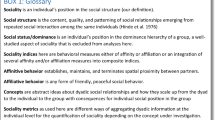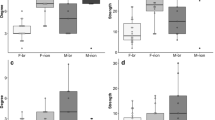Abstract
Studying the structure of social interactions is fundamental in behavioral ecology as social behavior often influences fitness and thus natural selection. However, social structure is often complex, and determining the most appropriate measures of variation in social behavior among individuals can be difficult. Social network analysis generates numerous, but often correlated, measures of individual connectedness derived from a network of interactions. We used measures of individual connectedness in networks of affiliative and agonistic interactions in yellow-bellied marmots, Marmota flaviventris, to first determine how variance was structured among network measures. Principal component analysis reduced our set of network measures to four “social attributes” (unweighted connectedness, affiliation strength, victimization, and bullying), which revealed differences between patterns of affiliative and agonistic interactions. We then used these extracted social attributes to examine the relationship between an individual’s social attributes and several performance measures: annual reproductive success, parasite infection, and basal stress. In male marmots, bullying was positively associated with annual reproductive success, while in females, affiliation strength was negatively associated with annual reproductive success. No other social attributes were significantly associated with any performance measures. Our study highlights the utility of considering multiple dimensions when measuring the structure and functional consequences of social behavior.
Similar content being viewed by others
References
Alexander RD (1974) The evolution of social behavior. Annu Rev Ecol Syst 5:325–383
Altizer S, Nunn CL, Thrall PH, Gittleman JL, Antonovics J, Cunningham AA, Dobson AP, Ezenwa V, Jones KE, Pedersen AB, Poss M, Pulliam JRC (2003) Social organization and parasite risk in mammals: integrating theory and empirical studies. Annu Rev Ecol Evol Syst 34:517–547
Anderson R, May RM (1991) Infectious disease of humans. Oxford University Press, Oxford
Armitage KB (1991a) Factors affecting corticosteroid concentrations in yellow-bellied marmots. Comp Biochem Physiol A 98:47–54
Armitage KB (1991b) Social and population dynamics of yellow-bellied marmots: results from long-term research. Annu Rev Ecol Syst 22:379–407
Armitage KB (1998) Reproductive strategies of yellow-bellied marmots: energy conservation and differences between the sexes. J Mammal 79:385–393
Armitage KB (2010) Individual fitness, social behavior, and population dynamics of yellow-bellied marmots. In: Billick I, Price MV (eds) The ecology of place: contributions of place-based research to ecological understanding. University of Chicago Press, Chicago, pp 134–154
Barrat A, Barthélemy M, Pastor-Satorras R, Vespignani A (2004) The architecture of complex weighted networks. Proc Natl Acad Sci USA 101:3747–3752
Barthélemy M, Barrat A, Pastor-Satorras R, Vespignani A (2005) Characterization and modeling of weighted networks. Phys A 346:34–43
Bates D, Maechler M (2009) lme4: linear mixed-effects models using S4 classes. R package version 0.999375-32
Blumstein DT, Patton ML, Saltzman W (2006) Faecal glucocorticoid metabolites and alarm calling in free-living yellow-bellied marmots. Biol Lett 2:29–32
Blumstein DT, Wey TW, Tang K (2009) A test of the social cohesion hypothesis: interactive female marmots remain at home. Proc R Soc Lond B 276:3007–3012
Blumstein DT, Lea AJ, Olson LE, Martin J (2010) Heritability of anti-predatory traits: vigilance and locomotor performance in marmots. J Evol Biol 23:879–887
Bordes F, Blumstein DT, Morand S (2007) Rodent sociality and parasite diversity. Biol Lett 3:692–694
Borgatti SP, Everett MG, Freeman LC (2006) UCINET for Windows: software for social network analysis, 6139th edn. Analytic Technologies, Harvard
Cameron EZ, Setsaas TH, Linklater WL (2009) Social bonds between unrelated females increase reproductive success in feral horses. Proc Natl Acad Sci USA 106:13850–13853
Cheney D, Seyfarth R, Smuts B (1986) Social relationships and social cognition in nonhuman primates. Science 234:1361–1366
Cohen S, Kaplan JR, Cunnick JE, Manuck SB, Rabin BS (1992) Chronic social stress, affiliation, and cellular immune response in nonhuman primates. Psychol Sci 3:301–304
Corner LAL, Pfeiffer DU, Morris RS (2003) Social-network analysis of Mycobacterium bovis transmission among captive brushtail possums (Trichosurus vulpecula). Prev Vet Med 59:147–167
Côté IM, Poulin R (1995) Parasitism and group size in social animals: a meta-analysis. Behav Ecol 6:159–165
Creel S (2001) Social dominance and stress hormones. Trends Ecol Evol 16:491–497
Croft DP, James R, Krause J (2008) Exploring animal social networks. Princeton University Press, Princeton
Csárdi G, Nepusz T (2009) iGraph library, 2nd edn. Free Software Foundation, Budapest
Das M, Penke ZP, van Hooff JARAM (1998) Postconflict affiliation and stress-related behavior of long-tailed macaque aggressors. Int J Primatol 19:53–71
De Vries AC, Glasper ER, Detillion CE (2003) Social modulation of stress responses. Physiol Behav 79:399–407
Engh AL, Siebert ER, Greenberg DA, Holekamp KE (2005) Patterns of alliance formation and postconflict aggression indicate spotted hyenas recognize third-party relationships. Anim Behav 69:209–217
Flack JC, Girvan M, de Waal FBM, Krakauer DC (2006) Policing stabilizes construction of social niches in primates. Nature 439:426–429
Formica VA, Wood CW, Larsen WB, Butterfield RE, Augat ME, Hougen HY, Brodie ED III (2012) Fitness consequences of social network position in a wild population of forked fungus beetles (Bolitotherus cornutus). J Evol Biol 25:130–137
Freeman LC (1979) Centrality in social networks: conceptual clarification. Soc Networks 1:215–239
Friedman SR, Aral S (2001) Social networks, risk-potential networks, health, and disease. J Urban Health 78:411–418
Godfrey SS, Bull CM, James R, Murray K (2009) Network structure and parasite transmission in a group living lizard, the gidgee skink, Egernia stokesii. Behav Ecol Sociobiol 63:1045–1056
Godfrey SS, Moore JA, Nelson NJ, Bull CM (2010) Social network structure and parasite infection patterns in a territorial reptile, the tuatara (Sphenodon punctatus). Int J Parasitol 40:1575–1585
Harrison A, Scantlebury M, Montgomery WI (2010) Body mass and sex-biased parasitism in wood mice Apodemus sylvaticus. Oikos 119:1099–1104
Hinde RA (1976) Interactions, relationships and social structure. Man 11:1–17
House JS, Landis KR, Umberson D (1988) Social relationships and health. Science 241:540–545
Huang B, Wey TW, Blumstein DT (2011) Correlates and consequences of dominance in a social rodent. Ethology 117:573–585
Keay JM, Singh J, Gaunt MC, Kaur T (2006) Fecal glucocorticoids and their metabolites as indicators of stress in various mammalian species: a literature review. J Zoo Wildl Med 37:234–244
Keeling MJ, Eames KTD (2005) Networks and epidemic models. J R Soc Interface 2:295–307
Krause J, Ruxton GD (2002) Living in groups. Oxford University Press, New York
Lea AJ, Blumstein DT, Wey TW, Martin JGA (2010) Heritable victimization and the benefits of agonistic relationships. Proc Natl Acad Sci USA 107:21587–21592
Lusseau D, Whitehead H, Gero S (2008) Incorporating uncertainty into the study of animal social networks. Anim Behav 75:1809–1815
Lusseau D, Barrett L, Henzi SP (2011) Formalising the multidimensional nature of social networks. arXiv:1101.3735v1
Madden JR, Drewe JA, Pearce GP, Clutton-Brock TH (2009) The social network structure of a wild meerkat population: 2. Intragroup interactions. Behav Ecol Sociobiol 64:81–95
McDonald DB (2007) Predicting fate from early connectivity in a social network. Proc Natl Acad Sci USA 104:10910–10914
Millspaugh JJ, Washburn BE (2004) Use of fecal glucocorticoid metabolite measures in conservation biology research: considerations for application and interpretation. Gen Comp Endocrinol 138:189–199
Moody J, White DR (2003) Structural cohesion and embeddedness: a hierarchical concept of social groups. Am Sociol Rev 68:103–127
Moore J (2002) Parasites and the behavior of animals. Oxford University Press, New York
Newman MEJ (2004) Analysis of weighted networks. Phys Rev E 70:056131
Nunn CL, Altizer S (2006) Infectious diseases in primates. Oxford University Press, New York
Olson LE, Blumstein DT (2010) Applying the coalitionary-traits metric: sociality without cooperation in male yellow-bellied marmots. Behav Ecol 21:957–965
Ozgul A, Childs DZ, Oli MK, Armitage KB, Blumstein DT, Olson LE, Tuljapurkar S, Coulson T (2010) Coupled dynamics of body mass and population growth in response to environmental change. Nature 466:482–485
R Development Core Team (2009) R: a language and environment for statistical computer. R Foundation for Statistical Computing, Vienna
Ryder TB, McDonald DB, Blake JG, Parker PG, Loiselle BA (2008) Social networks in the lek-mating wire-tailed manakin (Pipra filicauda). Proc R Soc Lond B 275:1367–1374
Sapolsky RM (2004) Social status and health in humans and other animals. Annu Rev Anthropol 33:393–418
Schwartz OA, Armitage KB, Van Vuren D (1998) A 32-year demography of yellow-bellied marmots (Marmota flaviventris). J Zool 246:337–346
Sheriff MJ, Dantzer B, Delehanty B, Palme R, Boonstra R (2011) Measuring stress in wildlife: techniques for quantifying glucocorticoids. Physiol Ecol 166:869–887
Shine R (1989) Ecological causes for the evolution of sexual dimorphism: a review of the evidence. Q Rev Biol 64:419–461
Sih A, Hanser SF, McHugh KA (2009) Social network theory: new insights and issues for behavioral ecologists. Behav Ecol Sociobiol 63:975–988
Silk JB, Alberts SC, Altmann J (2003) Social bonds of female baboons enhance infant survival. Science 302:1231–1234
Silk JB, Beehner JC, Bergman TJ, Crockford C, Engh AL, Moscovice LR, Wittig RM, Seyfarth RM, Cheney DL (2009) The benefits of social capital: close social bonds among female baboons enhance offspring survival. Proc R Soc Lond B 276:3099–3104
SPSS Inc (2007) SPSS 16.0 Graduate Student Version, 1602nd edn. SPSS, Chicago
Uchino BN, Cacioppo JT, Kiecolt-Glaser JK (1996) The relationship between social support and physiological processes: a review with emphasis on underlying mechanisms and implications for health. Psychol Bull 119:488–531
Van Vuren D (1996) Ectoparasites, fitness, and social behavior of yellow-bellied marmots. Ethology 102:686–694
Wasserman S, Faust K (1994) Social network analysis: methods and applications. Cambridge University Press, New York
Wey TW, Blumstein DT (2010) Social cohesion in yellow-bellied marmots is established through age and kin structuring. Anim Behav 79:1343–1352
Wey T, Blumstein DT, Shen W, Jordán F (2008) Social network analysis of animal behaviour: a promising tool for the study of sociality. Anim Behav 75:333–344
Whitehead H (2008) Analyzing animal societies: quantitative methods for vertebrate social analysis. University of Chicago Press, Chicago
Young AJ, Carlson AA, Monfort SL, Russell AF, Bennett NC, Clutton-Brock TH (2006) Stress and the suppression of subordinate reproduction in cooperatively breeding meerkats. Proc Natl Acad Sci USA 103:12005–12010
Acknowledgments
This work was funded by the US Department of Education GAANN Fellowship, National Science Foundation (NSF) GK-12 Fellowship, UCLA Chancellor’s Prize, RMBL Snyder Graduate Research Fellowship, Homes O. Miller Fellowship, and Bartholomew Research Grant (to TWW); the UCLA Academic Senate and Division of Life Sciences, National Geographic Society, and NSF-IDBR-0754247 (to DTB); and NSF-DBI 0242960, 0731346 (to the RMBL). We are also grateful to the many field and lab assistants for data collection; Lucretia E. Olson and Amanda J. Lea for genetic analyses; Rebecca N. Booth and the University of Washington Center for Conservation Biology for radioimmunoassay of hormone extractions; Johannes Foufopolous, Laura Ramos, and Dirk Van Vuren for advice on parasites; the UCLA ATS statistical consultants, especially Xiao Chen and Phil Ender, for help on statistical analysis; and Jennifer E. Smith, Amanda J. Lea, Rick Grannis, Peter Nonacs, Gerald Wilkinson, F. Stephen Dobson, and an anonymous reviewer for constructive feedback on earlier versions of the manuscript.
Ethical standards
The research was conducted in compliance with US regulations, under research protocol ARC no. 2001-191-01, approved by the University of California at Los Angeles Animal Research Committee on 13 May 2002 and renewed annually. Live animals were trapped under permits issued by the Colorado Division of Wildlife.
Conflict of interest
The authors declare that they have no conflict of interest.
Author information
Authors and Affiliations
Corresponding author
Additional information
Communicated by G. Wilkinson
Appendices
Appendix 1
Table 7
Appendix 2
Rights and permissions
About this article
Cite this article
Wey, T.W., Blumstein, D.T. Social attributes and associated performance measures in marmots: bigger male bullies and weakly affiliating females have higher annual reproductive success. Behav Ecol Sociobiol 66, 1075–1085 (2012). https://doi.org/10.1007/s00265-012-1358-8
Received:
Revised:
Accepted:
Published:
Issue Date:
DOI: https://doi.org/10.1007/s00265-012-1358-8




